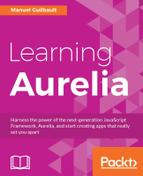Book Description
Harness the power of the next-generation JavaScript Framework, Aurelia, and start creating apps that really set you apart
About This Book
- Develop well-designed, decoupled, and testable single-page applications with Aurelia
- Leverage the latest web standards to increase code performance, readability, and cross-compatibility
- Understand how Aurelia is organized and use its innovative MVC approach to design professional-quality web apps
Who This Book Is For
This book is for JavaScript developers who want to build modern web apps with Aurelia. No prior knowledge of Aurelia is needed.
What You Will Learn
- Build a modern single-page web application
- Understand the workflow of an Aurelia application
- Design reusable web components, which can be shared and integrated into various frameworks and libraries
- Write clean, modular, and testable code that will be easy to maintain and evolve
- Use all the latest?and even future?web standards, so the application gathers minimal technical debt
In Detail
Aurelia is one of the most promising new JavaScript frameworks for mobile, desktop, and web, which makes developing powerful, modern web applications a straightforward task. Its power lies in its simplicity and clear workflow that enables developers to build next-generations apps for the web with ease.
From initial structuring to full deployment, this book will serve as a step-by-step guide to develop a modern web application from scratch with the Aurelia framework. In addition to including a comprehensive coverage of various Aurelia framework features, this book will also show you how to utilize these features in the real world to develop a professional single-page web application. You'll see how to make the most out of Aurelia by understanding the Aurelia workflow and then applying it in real-world development tasks. By the end of the book, you will have learned to develop a clean and maintainable application in Aurelia from scratch.
Style and approach
This book will show you how to leverage the cutting edge features of Aurelia framework to develop modern web apps with a clear workflow. Using the modern architecture and features of Aurelia, this book will demonstrate the development of a web application from scratch.
